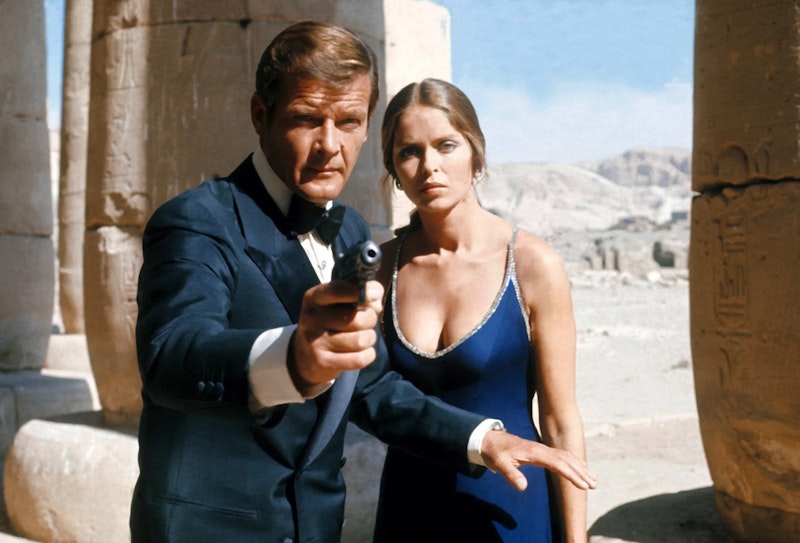There’s an argument that the pre-title sequence of The Spy Who Loved Me is the moment James Bond became one of the great British heroes—if not the level of Sherlock Holmes, at least greater than Bulldog Drummond or even Sexton Blake. After some plot points are set up, Bond’s introduced in a whirl of seduction, betrayal, excellent action filming, and great stuntwork culminating in mid-air drama resolved by an unconventional unfurling of the Union Jack. One report claims that at a screening attended by Prince Charles, he stood in salute at that climactic moment.
Whether that’s so or not, The Spy Who Loved Me is the strongest Bond film of the 1970s. After the well-paced opening, Bond’s sent to investigate the disappearance of British and Soviet nuclear submarines. His mission’s complicated by the Russians sending their best agent as well: Major Anya Amasova (Barbara Bach), code-named Agent XXX. The two of them adventure across Egypt, sometimes competing with each other and sometimes allying against the giant assassin Jaws (Richard Kiel), following a trail that leads to scientist and millionaire Karl Stromberg (Curt Jürgens). There are explosions, a car that turns into a submarine, a surprisingly effective character scene between Bond and Amasova, a climax aboard a disguised tanker, and a submersible base where Stromberg hopes to establish a new underwater civilization after annihilating the surface world in a nuclear war.
None of this is in Ian Fleming’s 1962 novel, barring a villain with unusual dental work. The book was hated by fans and critics (to me, it’s one of the more interesting Bond novels), and Fleming forbade adapting anything in it beyond the title. A number of scripters worked at coming up with a new story, including Anthony Burgess, comics scribe Cary Bates, and Gerry Anderson. Richard Maibaum did a draft trying to pull all the different takes together, and then Christopher Wood rewrote Maibaum’s work. Lewis Gilbert, director of You Only Live Twice, replaces Guy Hamilton, who’d directed the three previous films, and it makes a kind of sense as you watch it.
Ken Adam returns as production designer, and with Gilbert and cinematographer Claude Renoir the Bond franchise regains some visual interest. There’s a strikingly-lit scene among the pyramids that evokes a surprising sense of horror, a spectacular sun-drenched car chase in Sardinia, and a sub-capturing tanker with a grandeur that makes it a fine venue for a major action climax. Adam got tips on how to light the massive set from Stanley Kubrick, and sells the location as not merely enormous but threatening, with harsh illumination glinting on black metal and red-clad henchmen.
But none of that’s what makes the movie succeed, not really. Unusually for a Bond film, the movie works because of the chemistry between the two leads. You enjoy watching two supremely capable spies alternately betraying and working with each other, and enjoy watching the attraction between them grow. And you enjoy that nice character scene, where Amasova confronts Bond with his past actions, and you can see him considering the things he’s done and his justification for doing them.
Amasova is an interesting character. Much has been written about the depiction of women in the Bond films, and there’s a sense Amasova’s a healthy correction to the character of klutz supreme Mary Goodnight in the previous movie. The odd thing about the Bond films is that while the women in them are fantasy-figures who exemplify the film-critic term “male gaze,” the 20th-century Bond movies also often let them have more plot agency than was common for women characters in other action movies of their respective moments. So it is here—until that emotional scene with Bond’s self-reflection, after which Amasova’s importance fades and she’s captured by the baddie so Bond has somebody to rescue.
Perhaps it’s no coincidence that a sense of style returns to the Bond films in the same movie where Bond deals with a woman just about as strong-willed and competent as he is. Bond’s challenged on multiple levels, and possibly as a result the world around him becomes stranger, more dangerous, and more surreal. He fights a mute giant evoking both Dracula and Frankenstein’s Monster. He wanders into Egyptian ruins and finds an MI6 outpost—where a Russian general’s waiting for him.
And there are the gadgets, more than in the last couple of Bond films. The most notable is Bond’s Lotus Esprit, a sports car that takes off-road capability to a new level. A young Elon Musk apparently thought the car was the coolest thing in the world, and the design for Tesla’s cybertruck is based on the odd-angled vehicle. In fact the car looks like what the 1970s thought was cool, and so works in the context of this movie: this is the closest 1970s Bond gets to the spy-fi weirdness of the 1960s.
Similarly, the evil plot here is based on a high-tech fantasy, the evil Stromberg planning an undersea realm he’ll rule as dictator. But despite Curt Jürgens’ best efforts the part’s underwritten. The character never comes alive, a sketch of a villain more than an actual one. It’s a good idea, and again one must mention Musk: an evil billionaire who fantasizes about building a colony where human beings weren’t meant to live. Yet Stromberg has no development, no individuality, and not enough screen time to feel like a real threat.
At least there’s enough here to make an entertaining movie. The other Bond films of the 1970s always seem to be gearing up to fight the last war, trying to fuse James Bond with blaxploitation or kung-fu or science fiction. The Spy Who Loved Me has a few nods to Jaws, but is mostly content to be a strong, effective Bond film, one which suggests what the franchise might’ve become; how it could have built a world of Bondian high adventure for the 1970s and 1980s.

